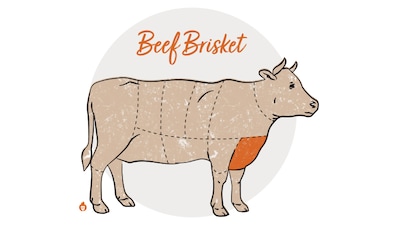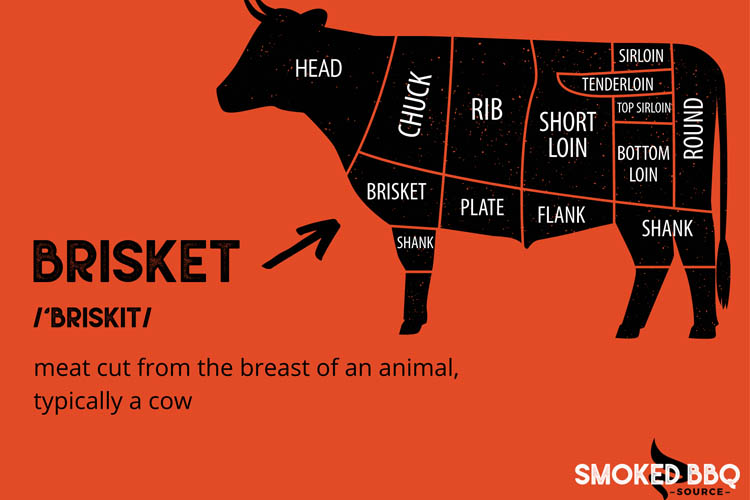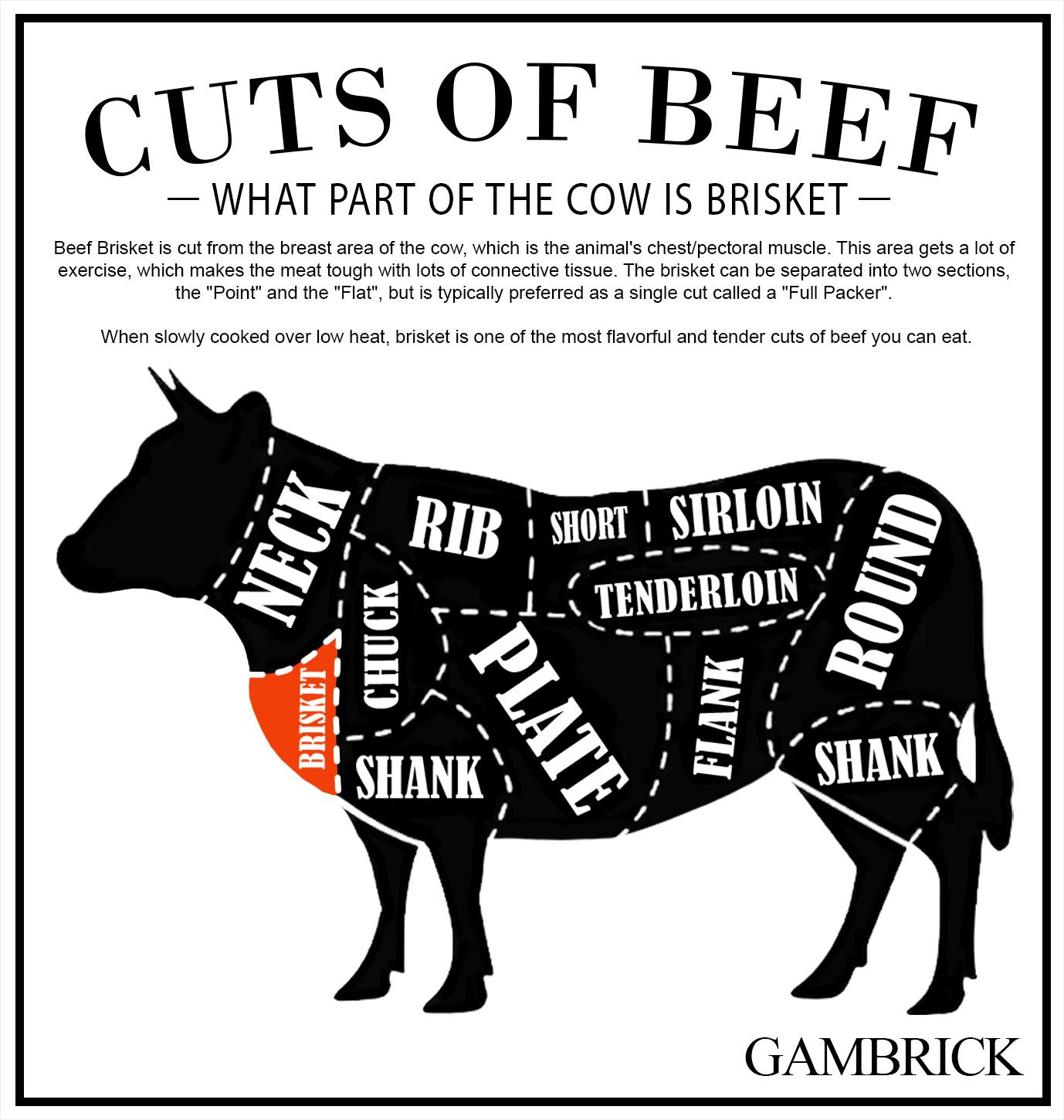Understanding The Anatomy Of A Cow

The anatomy of a cow plays a crucial role in understanding where the brisket is located. The brisket is found beneath the first five ribs on the underside of the cow, specifically in the lower chest area. This region is home to two distinct muscles that make up the brisket: the point and the flat. The point is located on the top side of the brisket and is known for its marbling and rich flavor. The flat, on the other hand, is positioned on the bottom side of the brisket and is leaner and more even in thickness. Knowing the location and characteristics of the brisket in a cow is essential for properly cooking and utilizing this popular cut of beef.
Location Of Brisket In A Cow
The brisket is located in the lower chest region of a cow, specifically beneath the first five ribs on the underside. This area is known as the “brisket” and is where the two muscles, the point and the flat, are found. The point muscle is situated on the top side of the brisket, known for its marbling and rich flavor. On the other hand, the flat muscle is positioned on the bottom side, leaner and more even in thickness. Understanding the location of the brisket in the cow is essential for cooking and utilizing this popular cut of beef.
Physical Characteristics Of Brisket
The brisket cut of beef is known for its unique physical characteristics. It consists of two main muscles, the point and the flat, which are separated by a layer of fat. The point muscle is well-marbled, resulting in rich flavor and tenderness when cooked. The flat muscle is leaner and has a more uniform thickness, making it ideal for slicing. Brisket also has a generous amount of connective tissue, which breaks down during the slow cooking process, resulting in a moist and tender texture. These physical characteristics contribute to the popularity of brisket as a favored cut for barbecue and smoking.
Definition And Importance Of Brisket

Brisket is a cut of beef that is widely recognized for its unique flavor and tenderness. It is derived from the lower chest region of a cow and consists of two main muscles, the point and the flat. The point muscle is well-marbled, adding richness to the meat, while the flat muscle is leaner, making it ideal for slicing. Brisket has become a staple in many cuisines, especially in barbecue and smoking. Its importance lies in its versatility, as it can be cooked in various ways and enjoyed in a multitude of dishes. So, whether it’s slow-cooked, smoked, or braised, brisket is a popular choice for meat lovers worldwide.
What Is Brisket And Its Culinary Significance
Brisket is a cut of beef that holds immense culinary significance. It is renowned for its unique flavor and tenderness, making it a favorite among meat lovers. The rich marbling of the point muscle adds a delightful richness, while the leaner flat muscle is perfect for slicing. Brisket is a popular choice for various cooking methods, such as slow-cooking, smoking, and braising. Its versatility makes it suitable for a wide range of dishes, from classic barbecue to gourmet cuisine. Whether it’s a tender brisket sandwich or a delectable plate of smoked brisket, this cut never fails to impress. So, its culinary significance lies in its unmatched taste, texture, and ability to elevate any dish it is used in.
Common Ways To Cook Brisket
Common ways to cook brisket include slow-cooking, smoking, and braising. Slow-cooking allows the meat to become tender and juicy, resulting in melt-in-your-mouth deliciousness. Smoking imparts a smoky flavor that perfectly complements the natural richness of brisket. It requires a longer cooking time but produces incredible results. Braising involves searing the meat on high heat, then cooking it slowly in a liquid until it becomes fork-tender. This method is ideal for creating flavorful and succulent brisket. Each cooking method offers its unique flavors and textures, allowing you to explore different taste profiles and find your preferred style.
Lower Chest Region: The Home Of Brisket

The lower chest region of a cow is the prime location for the delicious cut of beef known as brisket. This area, also referred to as the breast or pectoral area, is where the brisket can be found. It is a tough and sturdy cut of meat that consists of specific muscles in this area. The brisket is typically separated into two parts, the point and the flat, but it is often preferred and cooked as a whole packer. This region of the cow is responsible for producing the flavorful and tender meat that is beloved by brisket enthusiasts around the world.
Brisket’s Location On The Lower Chest Region Of A Cow
Located on the lower chest region of a cow, the brisket is a prized cut of meat for barbecue enthusiasts. It is situated between the shoulder and the chuck, making it a versatile and flavorful part of the cow. The muscles in this area contribute to the rich texture and marbling of the brisket. Whether you’re cooking the point, the flat, or a whole packer, the lower chest region is where the succulent and tender brisket can be found. Its position in the cow’s body makes it the perfect canvas for creating mouthwatering dishes.
Specific Muscles Comprising The Brisket Cut
The brisket cut consists of two main muscles: the pectoralis profundus and the pectoralis superficialis. The pectoralis profundus, also known as the deep pectoral muscle, is the primary muscle in the brisket. It is located deep within the chest cavity and contributes to the tenderness and flavor of the meat. The pectoralis superficialis, or superficial pectoral muscle, lies on top of the pectoralis profundus and adds to the overall texture and richness of the brisket. These muscles work together to create the succulent and juicy qualities that make brisket a sought-after cut for BBQ enthusiasts.
Brisket As A Popular Cut Of Beef

Brisket is undeniably a popular cut of beef that is beloved by meat enthusiasts around the world. Its rich, succulent flavor and tender texture make it a favorite choice for various cuisines and cooking styles. From classic American barbecue to Mexican barbacoa and Jewish-style braised brisket, this cut has made its mark in cultural and regional dishes. It is highly versatile and can be prepared in different ways, such as slow-cooking, smoking, or even braising. The popularity of brisket can be attributed to its ability to deliver a mouthwatering and satisfying dining experience, making it a go-to choice for meat lovers everywhere.
Brisket’s Popularity In Various Cuisines
Brisket’s popularity extends far beyond barbecue enthusiasts. This delicious cut of beef has found its way into various cuisines around the world. In American cuisine, it takes center stage as the star of slow-cooked smoked barbecue dishes. In Mexican cuisine, brisket is a key ingredient in traditional barbacoa, where it is seasoned with spices and cooked low and slow. Jewish cuisine embraces brisket as well, with the famous Jewish-style braised brisket. Its rich flavor and tender texture make it a versatile cut that adds depth and complexity to dishes across different cultures and cooking styles.
Cultural And Regional Significance Of Brisket Dishes
Brisket dishes hold immense cultural and regional significance in various cuisines around the world. In American cuisine, brisket takes center stage in the realm of barbecue, becoming a symbol of regional identity in places like Texas and Kansas City. It is deeply embedded in the cultural fabric of these regions, representing a tradition of slow-cooked, smoky goodness. In Jewish cuisine, brisket holds a special place as a key ingredient in the beloved Jewish-style braised brisket, enjoyed during holidays and special occasions. Across different cultures, brisket has become synonymous with celebration, bringing people together to savor its rich flavors and tender texture. Its popularity and versatility continue to make it a beloved culinary treasure.
Cooking Methods For Brisket

When it comes to cooking brisket, there are a few recommended methods that can help you achieve tender, flavorful results. One popular method is low and slow cooking, where the brisket is cooked at a low temperature (around 225-250°F) for a long period of time. This allows the connective tissues to break down slowly, resulting in a melt-in-your-mouth texture. Another method is braising, which involves searing the brisket first and then simmering it in a flavorful liquid, such as broth or red wine, until it’s fork-tender. Smoker and grill cooking are also common methods, where the brisket is slow-cooked over indirect heat with the addition of wood chips for a smoky flavor. Whichever cooking method you choose, it’s important to allow the brisket to rest for at least 15-30 minutes before slicing and serving to retain its juices.
Recommended Cooking Methods For Brisket
When it comes to cooking brisket, there are a few recommended methods that can help you achieve tender, flavorful results. One popular method is low and slow cooking, where the brisket is cooked at a low temperature (around 225-250°F) for a long period of time. This allows the connective tissues to break down slowly, resulting in a melt-in-your-mouth texture. Another method is braising, which involves searing the brisket first and then simmering it in a flavorful liquid, such as broth or red wine, until it’s fork-tender. Smoker and grill cooking are also common methods, where the brisket is slow-cooked over indirect heat with the addition of wood chips for a smoky flavor. Whichever cooking method you choose, it’s important to allow the brisket to rest for at least 15-30 minutes before slicing and serving to retain its juices.
Tips For Preparing And Cooking Brisket
- Choose the right cut: When buying brisket, look for a well-marbled piece with a good amount of fat. This will ensure a juicy and flavorful result.
- Trim excess fat: Trimming the fat cap to a thickness of 1/4 inch helps the brisket cook evenly and prevents it from becoming greasy.
- Season generously: Use a dry rub or marinade to enhance the flavor of the brisket. Make sure to season it at least an hour before cooking to allow the flavors to penetrate the meat.
- Preheat the smoker or grill: Before placing the brisket on the smoker or grill, make sure it is preheated to the desired temperature. This helps to maintain a consistent cooking temperature throughout the process.
- Monitor temperature: Invest in a good meat thermometer to accurately monitor the internal temperature of the brisket. The ideal temperature for a tender brisket is around 195-205°F.
- Wrap in foil or butcher paper: After a few hours of cooking, wrap the brisket in foil or butcher paper to retain moisture and enhance tenderness. This method, known as the Texas crutch, helps to speed up the cooking process.
- Rest before slicing: Once the brisket reaches the desired temperature, remove it from the heat and let it rest for at least 15-30 minutes. This allows the juices to redistribute, resulting in a moist and tender final product.
Remember, cooking brisket takes time and patience. With these tips, you’ll be well on your way to mastering the art of preparing and cooking a delicious brisket.
Conclusion

In conclusion, brisket is a flavorful and versatile cut of beef that is located in the lower chest region of a cow. Its popularity in various cuisines and its cultural significance make it a sought-after choice for barbecue and cooking enthusiasts. Whether you prefer smoking, grilling, or slow-cooking, brisket can be prepared in a variety of ways to create mouthwatering dishes. With proper trimming, seasoning, and cooking techniques, you can enjoy a tender and juicy brisket that is sure to impress your family and friends. So, next time you’re cooking beef, consider choosing brisket for a delicious and satisfying meal.
Nutritional Value And Versatility Of Brisket
Brisket not only offers a delicious taste but also provides nutritional benefits. It is a good source of protein, which is essential for muscle growth and repair. Additionally, brisket contains essential vitamins and minerals like iron, zinc, and B vitamins. The high-fat content in brisket adds flavor and juiciness to dishes.
In terms of versatility, brisket can be prepared in various ways. It can be slow-cooked for hours to achieve tender and melt-in-your-mouth texture, or it can be smoked for a smoky and robust flavor. Brisket can also be used in stews, soups, tacos, sandwiches, and even as a filling for dumplings. Its versatility makes it a favorite among home cooks and professional chefs alike.
FAQ About “what Part Of The Cow Is Brisket: Unveiling Brisket’s Location”
Q: What is brisket and where is it located on the cow?
A: Brisket is a cut of beef taken from the breast section of the cow, located below the first five ribs.
Q: How is brisket typically cooked?
A: Brisket is commonly cooked through methods such as smoking, braising, or slow cooking to break down its tough fibers and create a tender and flavorful result.
Q: What are the different types of brisket cuts?
A: The two main types of brisket cuts are the flat cut (also known as first cut) and the point cut (also known as the deckle). Each cut has its own texture and fat content.
Q: What dishes can be made using brisket?
A: Brisket is a versatile cut of meat that is popularly used to make dishes such as smoked brisket, beef brisket chili, brisket sandwiches, and Texas-style BBQ brisket.
Q: How should brisket be sliced for serving?
A: Brisket should be sliced against the grain to maximize tenderness. This means cutting perpendicular to the lines of muscle fibers to ensure each bite is as tender as possible.
Q: Is brisket a lean cut of meat?
A: Brisket is known for its rich marbling of fat, which adds flavor and juiciness to the meat. While it is not considered a lean cut, the fat renders during cooking, resulting in a delicious final product.

Johnny Knuckles Knock-out BBQ is a culinary haven for barbecue enthusiasts, offering a fusion of traditional BBQ and tantalizing street fare. Our secret to delivering mouthwatering dishes lies in our meticulous preparation process. Each cut of meat is lovingly hand-rubbed and slow-smoked over 100% hardwood, creating a symphony of flavors that will leave your taste buds dancing. Whether planning a special event or simply craving an unforgettable meal, Johnny Knuckles Knock-out BBQ is here to elevate your dining experience. Our catering services are designed to bring the sizzle and aroma of our delectable BBQ to your event, ensuring that every guest leaves with a full belly and a smile.